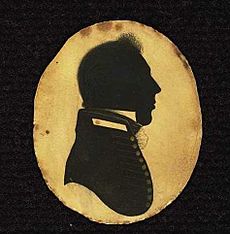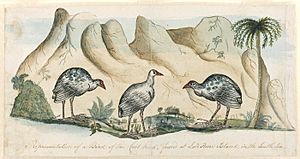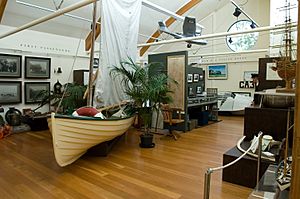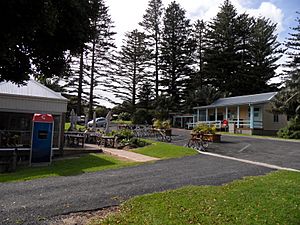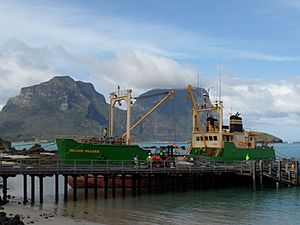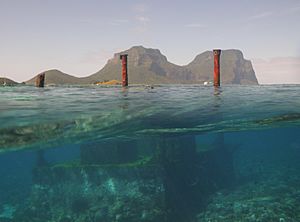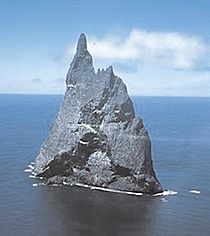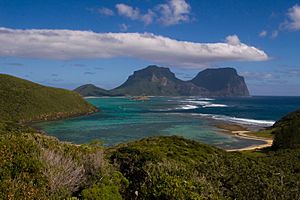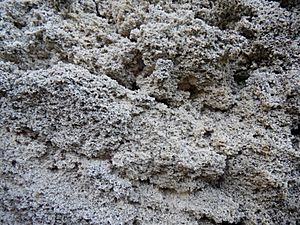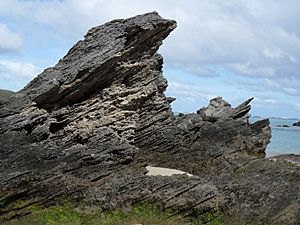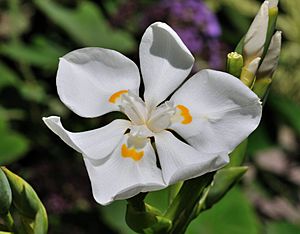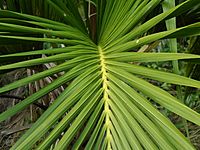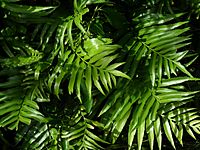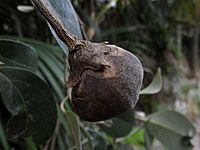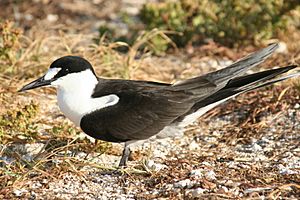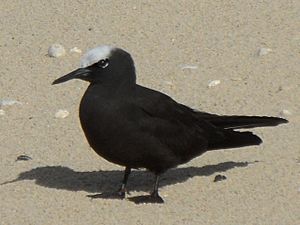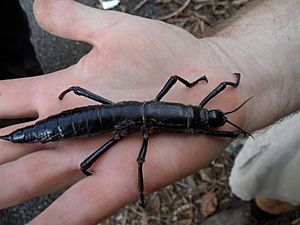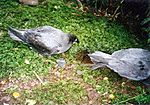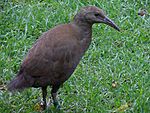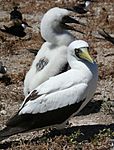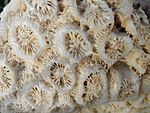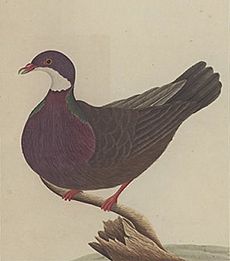Lord Howe Island Group facts for kids
Quick facts for kids Lord Howe Island Group * |
|
|---|---|
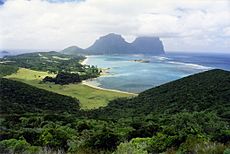
Lord Howe Island from Kim's Lookout
|
|
| Country | Australia |
| Type | Natural |
| Criteria | vii, x |
| Reference | 186 |
| Region ** | Asia-Pacific |
| Inscription history | |
| Inscription | 1982 (6th Session) |
|
|
Lord Howe Island is a beautiful island in the Tasman Sea. It's located between Australia and New Zealand. The island is about 600 km (370 mi) (370 miles) east of Port Macquarie in Australia.
Lord Howe Island is shaped like a crescent moon. It is about 10 km (6.2 mi) (6 miles) long. The island is between 0.3 and 2.0 km (0.19 and 1.24 mi) (0.2 and 1.2 miles) wide. Most people live in the northern part of the island. The southern part has tall, forested hills. The highest point is Mount Gower, which is 875 m, 2,871 ft (2,871 feet) high.
The Lord Howe Island Group includes 28 islands, islets, and rocks. One famous part is Ball's Pyramid. This tall, volcanic rock is about 23 km (14 mi) (14 miles) southeast of Lord Howe Island. It is not inhabited by people.
The first Europeans saw Lord Howe Island on February 17, 1788. Lieutenant Henry Lidgbird Ball was sailing from Botany Bay. He was on his way to set up a settlement on Norfolk Island. On his way back, he claimed Lord Howe Island for Britain.
The island became a place for whaling ships to get supplies. People started living there permanently in June 1834. Later, the island began exporting kentia palm seeds around the world. This is still a big part of the island's economy. Tourism also became important after World War II.
The UNESCO has named the Lord Howe Island Group a World Heritage Site. This means it's a very special natural place globally. Much of the island's forest is untouched. Many plants and animals here are found nowhere else. The island is also known for its coral reef, seabirds, and unique landscapes.
Contents
Island History: From Discovery to Today
First European Visits (1788–1834)
Before Europeans arrived, Lord Howe Island was empty. No people lived there. Lieutenant Henry Lidgbird Ball first saw the island in 1788. He was the commander of the ship HMS Supply. His ship was carrying convicts to Norfolk Island.
On his return trip, Ball landed on Lord Howe Island. He claimed it for Britain. His crew caught many turtles and tame birds. Ball named Mount Lidgbird and Ball's Pyramid after himself. He named the main island after Richard Howe, who was a top navy official.
Other ships from the First Fleet visited the island later that year. Their doctors and officers wrote about the plants and animals. Artists drew pictures of native birds. Sadly, some of these birds, like the white gallinule and Lord Howe pigeon, were soon hunted to extinction. Their paintings are the only records we have.
The island became a popular stop for whaling ships. Whaling was a huge industry back then. Ships would leave goats and pigs on the island. This was so future visitors would have food.
Early Settlement (1834–1860)
Permanent settlement began in June 1834. A whaling ship called Caroline landed there. Three men were left behind to set up a supply station. Their job was to provide meat by fishing and raising animals. They also brought their Māori wives and two Māori boys.
The first huts were built in an area called Old Settlement. There was fresh water there. They also started a garden. The settlers traded water, wood, vegetables, and meat. In return, they got clothes, tea, sugar, and tools from visiting ships.
These first settlers left in 1841. New businessmen took over. They brought their own employees to live on the island. By 1849, only 11 people lived there. But the island's farms soon grew.
When gold was found in Australia in the 1850s, many sailors left their ships. They wanted to dig for gold instead. This meant more ships avoided the mainland. So, Lord Howe Island saw more trade. The islanders grew potatoes, carrots, corn, and other vegetables.
In 1851, about 16 people lived on the island. Scientists also started visiting. They studied the island's geology, plants, and animals. In 1855, the island officially became part of New South Wales.
Scientific Expeditions and New Industries (1861–1890)
Whaling began to decline in the 1860s. This was due to new fuels like petroleum. The American Civil War also affected the industry. Islanders needed new ways to make money.
In 1869, a magistrate visited the island. He was with Charles Moore, who was the director of the Botanic Gardens in Sydney. They collected plant samples. By 1875, 195 plant species had been listed.
In 1876, a report suggested growing coffee. But the kentia palm was already getting worldwide attention. In 1878, the island was made a Forest Reserve. Captain Richard Armstrong became the first government administrator. He helped set up schools and encouraged the palm trade. He also built roads.
By 1882, the island's population had grown. There were 29 children. A schoolmaster was needed. This period helped create a lasting link with scientific groups. These included the Australian Museum and the Sydney Royal Botanic Gardens.
Modern Era (1890s–Today)
In 1883, a company started regular shipping services. More tourists began to visit. By 1932, tourism was the second biggest source of income. Selling palm seeds to Europe was the first.
The first plane landed on the island in 1931. It was a floatplane that landed on the lagoon. After World War II, flying boats brought tourists. In 1974, Lord Howe Island Airport was built. Seaplanes were replaced by modern aircraft.
In 2002, a navy ship hit a reef near the island. It almost sank. Tourism has continued to grow. The government of New South Wales is now very involved in protecting the island.
One big issue for islanders today is the rodent problem. Rats arrived in 1918 after a shipwreck. They have caused several bird species to disappear. They also harmed the Lord Howe Island stick insect. There is a plan to drop rat bait across the island. However, people have different opinions about it.
Island Life and Governance
Who Lives on Lord Howe Island?
In 2016, 382 people lived on Lord Howe Island. The number of tourists is limited to 400 at any time. Early settlers were European and American whalers. Many of their descendants still live on the island.
Today, residents work in the kentia palm industry, tourism, retail, fishing, and farming. Most people are Christian, but many have no religion. The population is almost equally split between men and women. Most residents are between 25 and 54 years old. About 92% are Australian citizens.
How the Island is Managed
The Lord Howe Island Board manages the island. It's a government authority in New South Wales. The Board reports to the Minister for Environment and Heritage. Its job is to protect the island's World Heritage values. It also controls development and manages public land. The Board provides community services and infrastructure. It also regulates tourism to keep it sustainable.
In 1981, islanders gained more power in the Board. Now, four of the seven Board members are elected by the island community. This gives the local residents a lot of say in how the island is run. The Board also manages the Kentia Palm Nursery. This nursery, along with tourism, brings money to the island.
Land ownership has been a topic of discussion since the first settlers. Originally, settlers just lived on the land without formal ownership. Over time, rules were made. Today, descendants of early settlers can get permanent leases on land. Other residents can get short-term leases for farming.
Island Economy: Palms and Tourism
After the whaling industry ended in the 1870s, Lord Howe Island needed new ways to make money. Today, the island's economy relies on two main things: tourism and selling kentia palm seeds and seedlings.
The Kentia Palm Industry
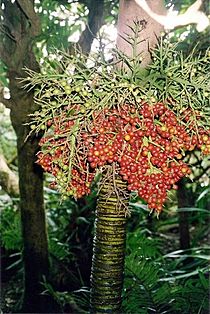
The kentia palm is one of four palm types found only on Lord Howe Island. It grows naturally in the lowlands. In the 1880s, people discovered that this palm was perfect for indoor conservatories in Europe and America.
The Lord Howe Island Kentia Palm Nursery was started in 1906. This helped the business grow. The native kentia palm is now the most popular decorative palm in the world. It can handle low light, dry air, and cool temperatures. This makes it ideal for indoor spaces.
The nursery sells high-quality seedlings. Collectors, many of whom are descendants of the first settlers, gather the seeds. The seeds are carefully prepared and tested. Then, they are packed and shipped around the world. The money earned from the nursery helps protect the island's environment.
Tourism on Lord Howe Island
Lord Howe Island is famous for its unique geology, birds, plants, and marine life. Popular activities for tourists include scuba diving, birdwatching, snorkelling, surfing, kayaking, and fishing.
To protect the island's delicate environment, only 400 tourists are allowed at one time. You can reach the island by plane from Sydney Airport or Brisbane Airport. The flight takes less than two hours. A large part of the island is a "Permanent Park Preserve." This area is managed like a national park.
Tourist Facilities
Since there are fewer than 800 people on the island at any time, facilities are limited. There is a bakery, a butcher, and a general store. You can also find a liquor store, restaurants, a post office, and a museum. There's a police officer, a park ranger, and an ATM at the bowling club.
Supplies arrive on the island every two weeks by a ship called the Island Trader. The island has a small four-bed hospital. There is also a small botanic garden. There is no public transport or mobile phone service. However, there are public phones and internet access. The island also has a local radio station and newsletter.
Tourist accommodation ranges from fancy lodges to apartments. The currency is the Australian dollar. There are no camping facilities. To protect the rare Howe Island stick insect, climbing Ball's Pyramid is not allowed. You also need permission from the Board to bring pets.
Fun Activities for Visitors
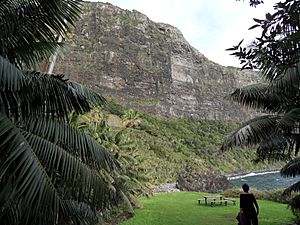
The island is small, so cycling is a great way to get around. Other fun activities include golf, lawn bowls, and tennis. You can also go fishing, yachting, windsurfing, kitesurfing, and kayaking. Boat trips are popular, including glass-bottom tours of the lagoon.
Swimming, snorkelling, and scuba diving are popular in the lagoon. You can also dive off Tenth of June Island. This is where you can see beautiful gorgonia and black coral. Diving sites are also found off Ball's Pyramid. Here, you can explore trenches, caves, and volcanic drop-offs.
Many walking tracks cover the island. You can take natural history tours and guided walks. The most challenging hike is an eight-hour guided trip to the top of Mount Gower. There are 11 beaches on the island. A very popular activity is hand-feeding the 1-metre-long (3 ft) kingfish and large wrasse at Ned's Beach.
Island Geography
Lord Howe Island is a volcanic island in the southwest Pacific Ocean. It's in the Tasman Sea, between Australia and New Zealand. The island is shaped like a crescent. It is about 10 km (6.2 mi) (6 miles) long and 0.3 and 2.0 km (0.19 and 1.24 mi) (0.2 and 1.2 miles) wide. Its total area is 14.55 km2 (5.62 sq mi) (5.6 square miles).
Along the west coast, there is a calm coral reef lagoon with white sand. This is where most of the island's eleven beaches are found. Both the north and south parts of the island have high ground with untouched forests. In the south, there are two volcanic mountains. These are Mount Lidgbird (777 m (2,549 ft)) and Mount Gower (875 m (2,871 ft)). Mount Gower is the highest point on the island.
The two mountains are separated by a low area called a saddle. In the north, where most people live, high points include Malabar (209 m (686 ft)) and Mount Eliza (147 m (482 ft)). Between these high areas is a cleared lowland. This is where you find some farms, the airstrip, and houses.
The Lord Howe Island Group includes 28 islands, islets, and rocks. The most famous is Ball's Pyramid. This is a 551-metre-high (1,808 ft) eroded volcano. It is about 23 km (14 mi) (14 miles) to the southeast. It is uninhabited by people. It is home to the only known wild population of the Lord Howe Island stick insect. To the north, there is the Admiralty Group. This is a group of seven small, uninhabited islands.
How the Island Was Formed
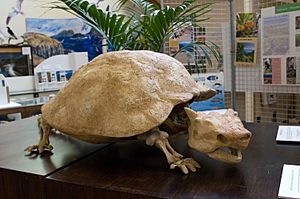
Lord Howe Island is what's left of a 7-million-year-old shield volcano. It formed from volcanic eruptions that lasted about 500,000 years. The island is part of a chain of islands. These islands are on the western edge of an undersea shelf called the Lord Howe Rise.
This shelf is part of Zealandia, a microcontinent that is almost half the size of Australia. It slowly sank after breaking away from the ancient supercontinent Gondwana. The Lord Howe Seamount Chain stretches north of the island for 1,000 km (620 mi). This chain of nine volcanic peaks was likely formed as the Indo-Australian plate moved over a stationary hotspot.
Rocks and Land
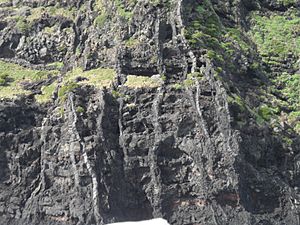
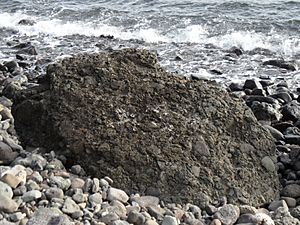
Two main periods of volcanic activity shaped the island. The first, about 6.9 million years ago, created the northern and central hills. The younger Mount Gower and Mount Lidgbird formed about 6.3 million years ago. They were made by layers of basalt lava flows. You can see these layers on the mountain cliffs.
Volcanic rock pieces can be seen on Roach Island and Boat Harbour. These include tuff (ash) and breccia (rock with angular blocks). The island is eroding quickly. Scientists believe it will be fully underwater within 200,000 years.
At the base of the mountains, you'll find calcarenite. This is a type of coral sand. It was blown inland long ago and hardened into layers. This rock contains fossils of bird bones, eggs, and snails. It also has fossils of the extinct horned turtle.
The island's crescent shape protects a coral reef and lagoon. This barrier reef is the southernmost in the world. The beach sands are made of shell, coral, and basalt pieces. This is different from mainland beaches, which have quartz grains.
Island Climate
Lord Howe Island has a subtropical climate. This means it has warm summers and very mild winters. The rainfall can be heavy in summer. In winter, rain is more even.
Winds are common. They are usually moderate easterlies in summer. In winter, they are strong westerlies. July is the windiest month. Winter months often have strong winds and gales. The island has about 68 clear days each year.
Storms and occasional cyclones can also affect the island. Rainfall varies a lot from year to year. July and August are the coldest months. Average low temperatures are about 13 °C (55 °F) (55°F). There is no frost. Average high temperatures range from 17–20 °C (63–68 °F) (63-68°F) in winter to 24–27 °C (75–81 °F) (75-81°F) in summer. The humidity is usually between 60-70% all year.
The average sea temperature ranges from 20.0 °C (68.0 °F) (68°F) in winter to 25.3 °C (77.5 °F) (77.5°F) in March.
Plants and Animals of Lord Howe Island
Unique Plants
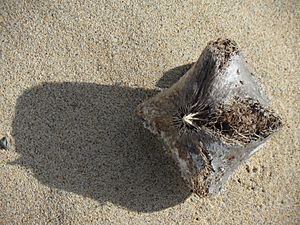
Lord Howe Island is a special terrestrial ecoregion. It is known as the Lord Howe Island subtropical forests. Almost half of the island's native plants are endemic. This means they are found nowhere else in the world. Many unique plants grow on the mountain tops. Here, the height allows for a cloud forest.
One of the most famous plants is the Howea palm. This is a group of palms found only here. They are commonly known as kentia palms. They make beautiful houseplants. Selling these palms brings in over A$2 million each year. This is a major industry for the island.
How Plants Arrived
Lord Howe Island is only 7 million years old. It was never connected to any continent. Its plants and animals arrived by crossing the sea. They were carried by wind, water, or birds. Over time, these species evolved into unique forms.
The island has five plant groups found only here. These include Negria, Lordhowea, Howea, Lepidorrhachis, and Hedyscepe. The plants are similar to those on Norfolk Island. They also have links to New Zealand and New Caledonia. Some plants, like the wedding lily, even have relatives in South Africa. This shows a link to the ancient supercontinent Gondwana.
The island's plant life is mostly untouched. Many rare plants grow here. About 44% of them are found only on the island. The island has different environments, from valleys to misty mountain tops. This allows for many types of plant communities. There are 57 species of fern, and 25 of them are endemic.
Special Plants to See
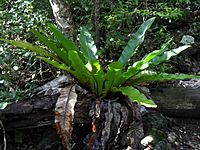
Several plants are easy to spot. The Banyan tree has a huge trunk and hanging roots. You can see it near Ned's Beach. The Pandanus tree has cool, teepee-like roots. Its leaves are used for making baskets.
There are ten types of orchid on the island. The bush orchid has cream flowers from August to September. Other bright flowers in summer include the red mountain rose and yellow corokia. The pumpkin tree has orange flowers. The kava bush has large, heart-shaped leaves. After rain, you might even see glowing mushrooms in the palm forests.
The palms are the most famous plants. The kentia and curly palms grow everywhere. All four species of palms are found only on the island. The kentia or thatch palm is a lowland palm. It has drooping leaves. The curly palm grows a bit higher. It has upward-pointing leaves. On the mountain sides, you'll find the big mountain palm and the little mountain palm.
Amazing Animals
Good news! There are no snakes on Lord Howe Island. There are also no highly venomous or stinging insects, animals, or plants. You won't find dangerous sharks off the beaches during the day.
Birds of the Island
More than 200 different birds have been seen on the island. Eighteen types of land birds breed here. Many more are migratory species. They are often so tame that you can get very close to them.
Lord Howe Island is an important place for birds. It is home to all the Lord Howe woodhens in the world. It also has most of the breeding providence petrels. Over 1% of the world's population of five other seabird species live here.
Fourteen types of seabirds breed on the island. Red-tailed tropicbirds fly in circles near the Malabar cliffs. Thousands of flesh-footed and wedge-tailed shearwaters return to the island at dusk. The providence petrel is one of the world's rarest birds. It is very tame.
The Lord Howe woodhen is a flightless bird found only here. Its ancestors could fly, but they lost this ability. This made them easy prey. By the 1970s, there were fewer than 30 woodhens left. But thanks to conservation efforts, their numbers have grown. They are now much safer.
Other Animals
Only one native mammal remains on the islands: the large forest bat. The Lord Howe long-eared bat is thought to be extinct. This might be because ship rats were introduced.
Two native reptiles live on the island: the Lord Howe Island skink and the Lord Howe Island gecko. They are rare on the main island but common on smaller islands nearby.
Invertebrates and Marine Life
The Lord Howe Island stick insect disappeared from the main island after rats arrived in 1918. In 2001, a tiny group was found on Ball's Pyramid. They are now being bred in captivity. Soon, they will be brought back to the main island. The Lord Howe stag beetle is a colorful beetle found only here. The Lord Howe flax snail is also endangered due to rats.
The marine environment around the island is very clean. It has a mix of temperate, subtropical, and tropical species. This is because of the different ocean currents. There are 490 fish species recorded, and 13 are found only here. You can catch yellowtail kingfish and New Zealand bluefish. Larger game fish include marlin and tuna. Over 80 species of coral live in the reefs.
You might also see whales and Bottlenose dolphins. Humpback whales migrate past the island. Historically, many large whales lived here. But their numbers were greatly reduced by hunting.
- Images of native fauna
Protecting Lord Howe Island
About 10% of Lord Howe Island's forests have been cleared. Another 20% has been disturbed. But 70% of the island remains untouched. It has many unique plants and animals. Some are rare or threatened.
Since 1778, two plant species, nine land birds, one bat, and at least four invertebrates have disappeared forever. Many unique types of palms, a daisy, a tree, and several insects and worms are found only here.
In 1981, a "Permanent Park Preserve" was created. This protects the north and south ends of the island. The National Parks and Wildlife Service manages this area. A ranger is stationed on the island. In 1982, the island was named a UNESCO World Heritage Site.
The waters around the island are also protected. They are part of the Lord Howe Island Marine Park. This park covers about 3,005 square kilometres (1,160 sq mi).
Dealing with Invasive Species
Pigs and goats were brought to the island in the early 1800s. They destroyed plants and ate eggs. Several birds became extinct because of hunting or crop protection. These included the Lord Howe swamphen and the white-throated pigeon.
In 1918, black rats accidentally arrived from a shipwreck. This caused more extinctions. Birds like the vinous-tinted thrush and Lord Howe starling disappeared. Rats also harmed the native stick insect and palm fruits. Programs have been put in place to control rats.
Invasive plants like Crofton weed and Formosa lily are also a problem. Efforts are being made to remove these weeds. The Lord Howe Island Board has a special team to manage plants. They map weeds and have an eradication program.
Feral pigs and cats were removed by the early 2000s. The goat population has also been greatly reduced. In 2012, the Australian and NSW Governments planned to spend A$9 million to get rid of rodents. This plan involves dropping poison baits from the air. The community is divided on this issue.
The recovery program for the Lord Howe woodhen has been very successful. Their numbers grew from only 20 in 1970 to about 200 in 2000.
Climate Change Concerns
Scientists believe that climate change and global warming threaten Lord Howe Island's ecosystem. The reefs are at risk from rising water temperatures. Plants and animals that prefer cool climates are also in danger. This is because they have limited places to move to higher, cooler areas.
Heritage Listings
The Lord Howe Islands Group is on the World Heritage List. It's recognized for its unique landforms and living things. It has diverse and mostly untouched ecosystems. It is also very beautiful. It provides homes for threatened species. The island also has important cultural history for New South Wales.
The Lord Howe Island Group was added to the Australian National Heritage List on May 21, 2007. This was based on its World Heritage status.
Lord Howe Island was also listed on the New South Wales State Heritage Register on April 2, 1999.
Related pages
Images for kids
-
Skeleton of Meiolania platyceps, once native to Lorde Howe
-
Parrot fish swimming in the waters of Ned's Beach
See also
 In Spanish: Isla de Lord Howe para niños
In Spanish: Isla de Lord Howe para niños


